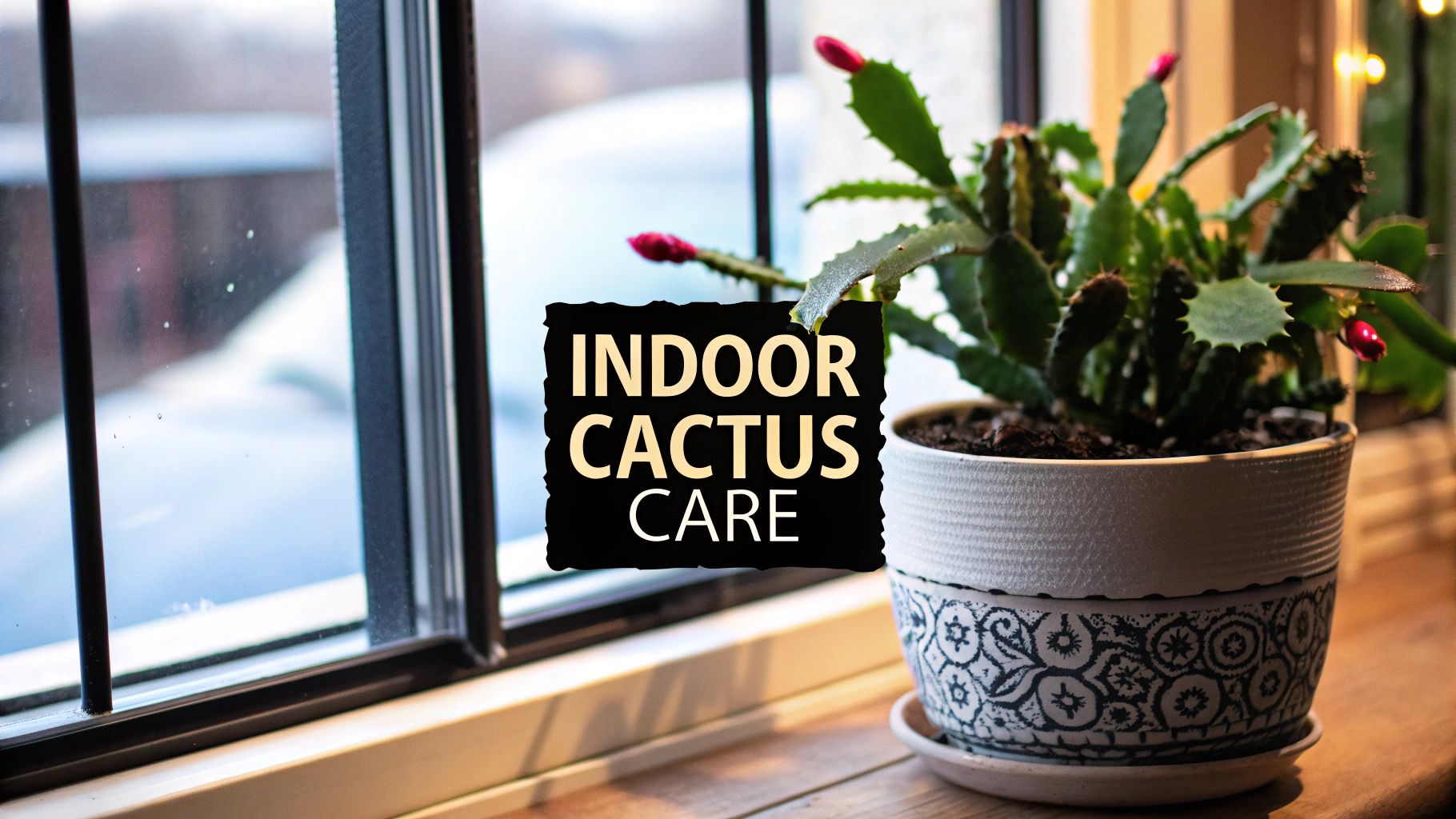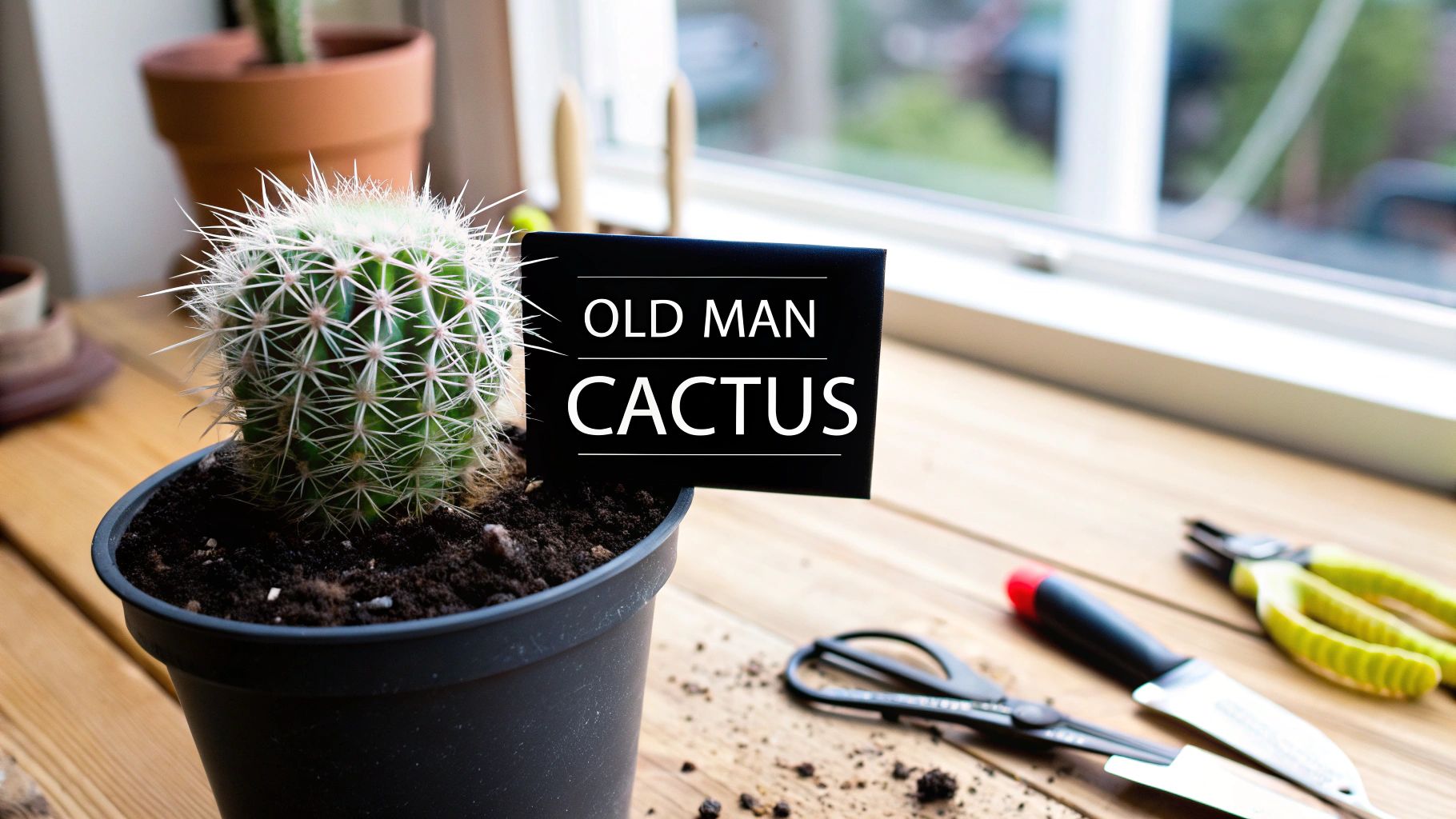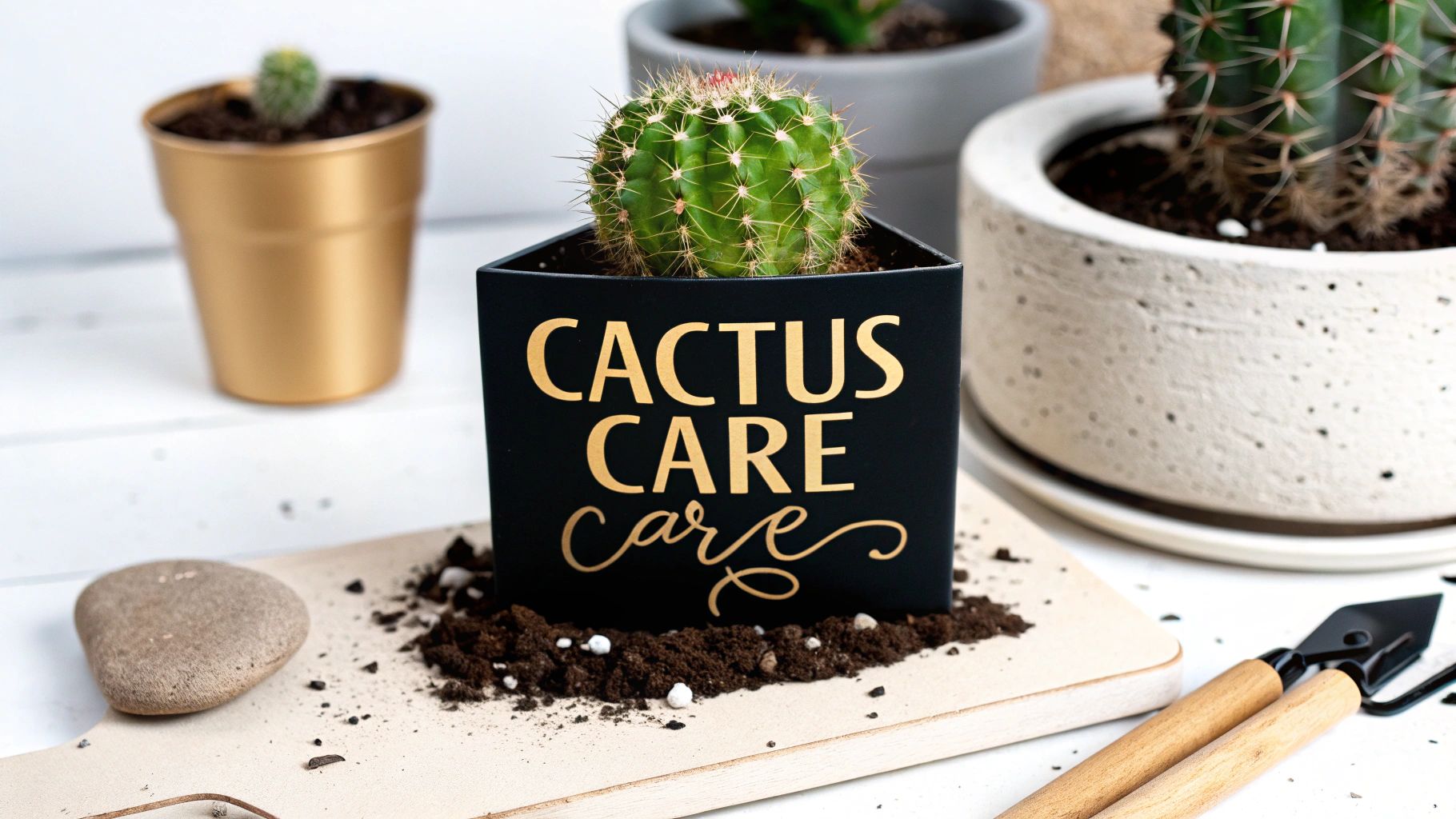Learning how to care for a Christmas cactus indoors is a lot simpler than you might think. If you give it bright, indirect light, water it only when the top inch of soil feels dry, and keep it in a spot with a consistent room temperature, you'll see this plant absolutely flourish. It's a tropical native, so its needs are quite different from its desert-dwelling relatives.
Unlocking the Secrets to a Thriving Christmas Cactus
Ever wonder how some people get their Christmas cactus to just explode with color every single holiday season? It’s not about luck. It’s about understanding what this unique plant truly needs. Unlike its desert cousins, the Christmas cactus is a tropical plant, and its care requirements are completely different. Forget about scorching sun and bone-dry conditions; this plant thrives with a much gentler touch.
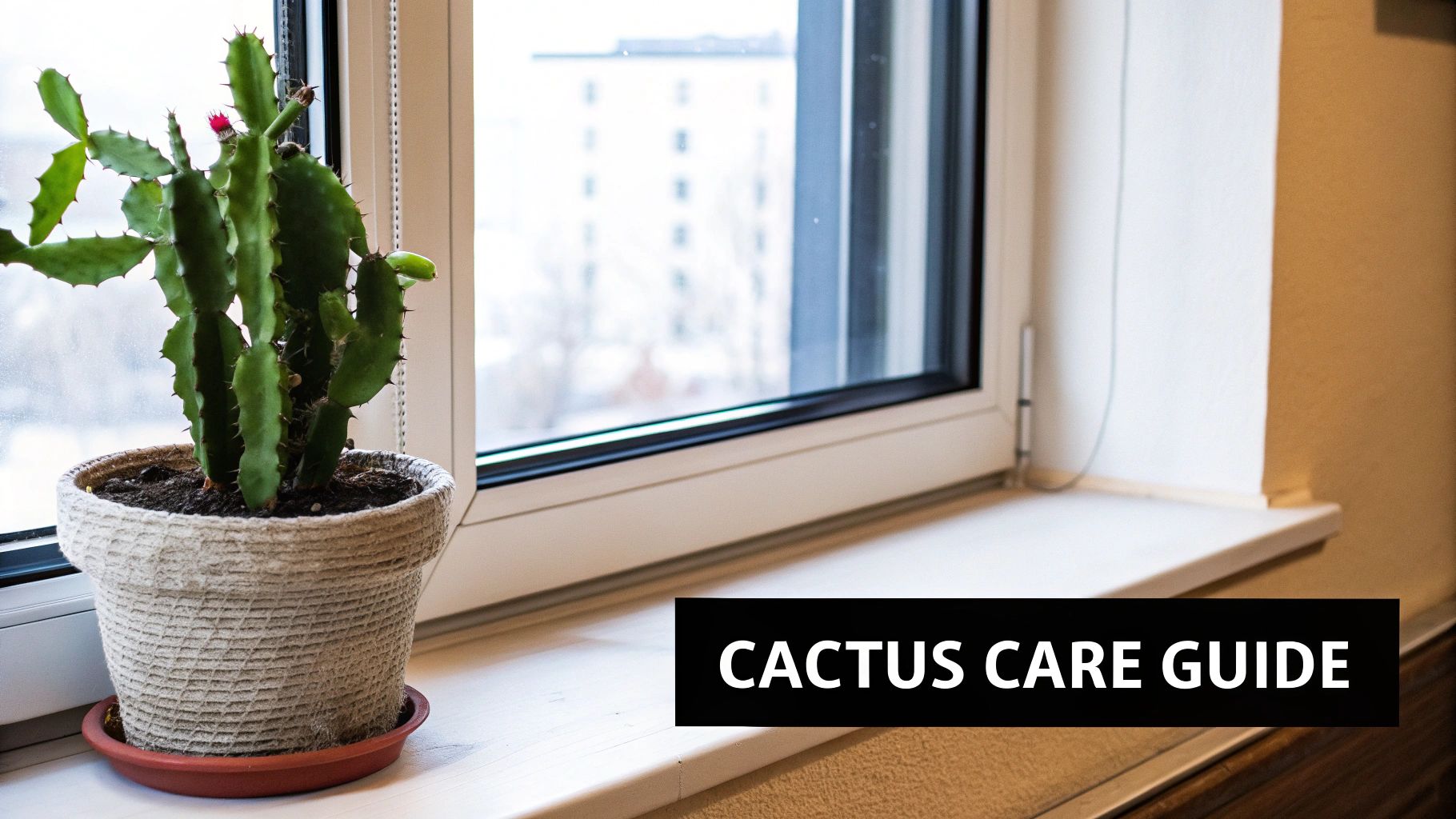
Mimicking Its Natural Home
The real key is to try and replicate its native environment. The Christmas cactus (Schlumbergera spp.) originally comes from the coastal rainforests of southeastern Brazil. There, it grows on tree branches, not in the ground, which means it’s used to filtered light, good humidity, and soil that drains incredibly well.
Getting this right in your home just comes down to a few core principles:
- Light: Find a spot that gets bright but indirect sunlight. An east-facing window is usually the perfect location.
- Water: This is a big one—avoid overwatering at all costs. I always let the top inch or so of soil dry out completely before watering again.
- Temperature: Keep your plant somewhere stable, away from drafty windows, heating vents, or sudden temperature swings.
The goal is consistency. These plants are really sensitive to abrupt changes in their environment, which can cause them to drop their precious buds or show other signs of stress. A stable, comfortable spot is the foundation for success.
A Christmas cactus is happiest indoors when conditions stay within a temperature range of 60-75°F (15-24°C) during the day. It also appreciates slightly cooler nights, around 50-65°F (10-18°C), which helps encourage blooming. You can find more great insights on Christmas cactus care at Gardening Know How.
For a quick reference, I've put together a little cheat sheet below. It summarizes the key conditions for success and will help you get started on the right foot.
Christmas Cactus Indoor Care at a Glance
This table gives you a snapshot of the ideal environment to create for your plant.
| Care Aspect | Ideal Condition |
|---|---|
| Lighting | Bright, indirect sunlight |
| Watering | Water when top 1-2 inches of soil is dry |
| Temperature | 60-75°F (15-24°C) day; 50-65°F (10-18°C) night |
| Humidity | 40-50% humidity is ideal |
| Soil Type | Well-draining mix (e.g., potting soil with perlite) |
| Fertilizer | Balanced liquid fertilizer during growing season |
Think of these as your guiding principles. Nailing these basics will make all the difference in keeping your Christmas cactus healthy and getting those beautiful holiday blooms year after year.
Finding the Perfect Light and Temperature Balance
One of the biggest mistakes I see people make with Christmas cactus is treating it like its desert cousins. It’s easy to do, given the name! But this plant is actually a tropical epiphyte, originally from the rainforests of Brazil. It grows in the shady canopy of trees, which means it needs filtered light, not the harsh sun most cacti crave.

Finding the right spot is everything. From my experience, an east-facing window is the sweet spot—it provides gentle morning sun that won't scorch the leaves. A north-facing window is another solid choice. If your only options are a bright south or west-facing window, just pull the plant back a few feet. You want it to get plenty of bright light, just not the direct, intense rays.
Your plant will tell you if the lighting is off. If you see the leaf segments turning reddish or purple, that’s a classic sign of sunburn. On the flip side, if the growth looks lanky and stretched out and it refuses to flower, it’s probably not getting enough light. For a deeper dive, check out our guide on how much sunlight a Christmas cactus needs.
Creating the Ideal Climate for Blooms
Temperature is just as critical as light, especially when you want those beautiful holiday blooms. Generally, your Christmas cactus will be perfectly content with daytime temperatures between 65-75°F (18-24°C).
The real secret to triggering flowers, though, is a strategic drop in temperature in the fall. To encourage buds to form, the plant needs cooler nights, somewhere around 50-55°F (10-13°C). This dip mimics the seasonal shift in its native environment, which is the signal to start flowering. Just be sure to keep it away from drafts, radiators, or fireplaces, as those sudden temperature swings can stress it out and cause it to drop its precious buds.
A common reason a healthy-looking plant fails to bloom is a lack of this crucial cool period. I've found that simply moving a stubborn cactus to a cooler room at night for a few weeks in the fall can make all the difference.
Studies back this up—temperature stability is huge. Swings above 75°F or drops below 50°F can lead to a 25% reduction in bloom success. It's also worth noting that around 80% of gardeners report that keeping the plant out of direct sun is the key to preventing leaf burn and getting that lush, green foliage we all love. For more great tips, check out this growing guide for Christmas cactus from Planet Desert.
Mastering Watering and Humidity
If there’s one mistake people make with their Christmas cactus, it’s overwatering. It's an easy trap to fall into. While it is a cactus, it's a tropical one, not a desert dweller, making it incredibly prone to root rot. So, the first thing to do is toss out any idea of a rigid watering schedule. The key is to check the soil yourself.
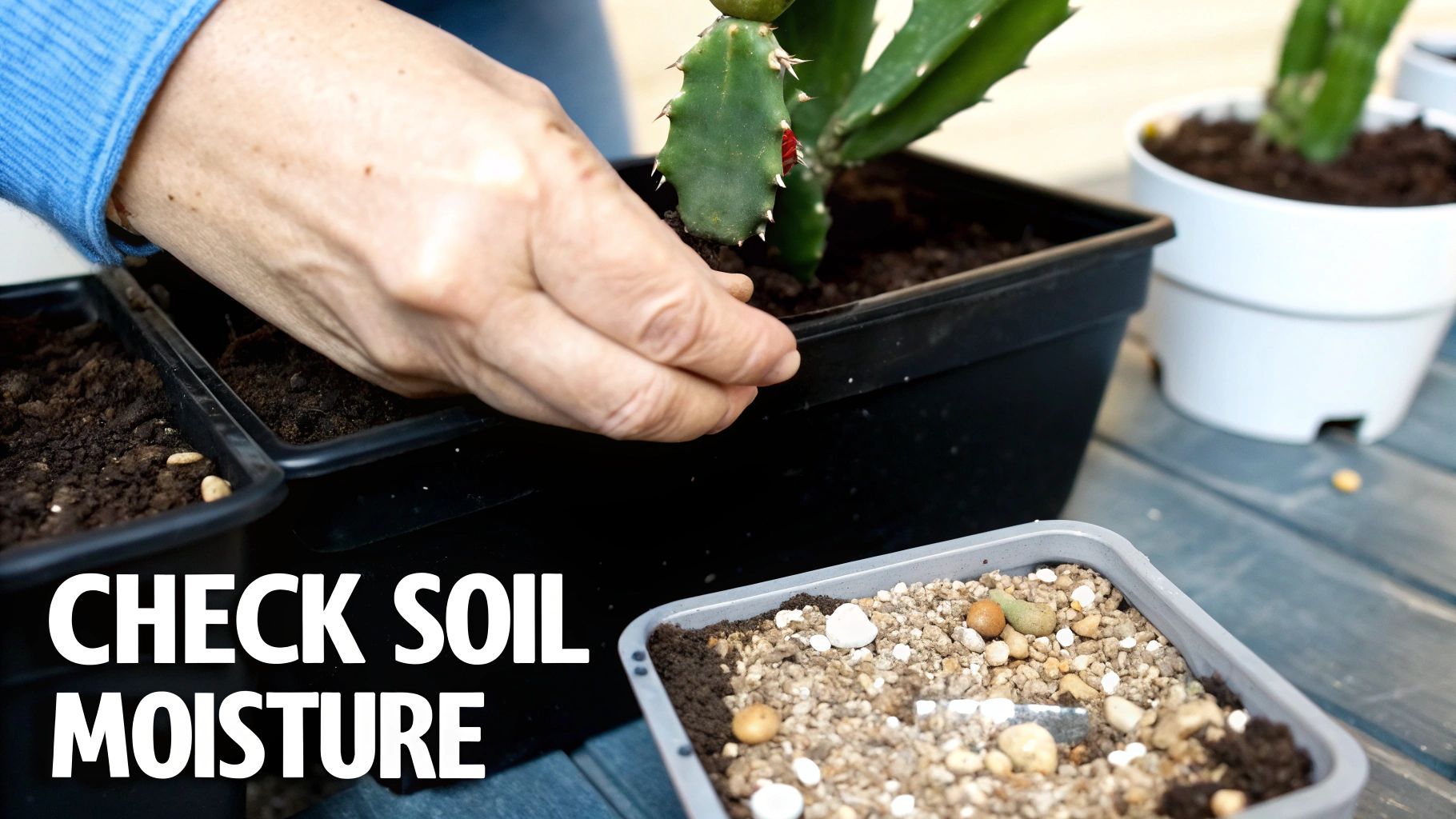
I always rely on the good old-fashioned “finger test.” Simply poke your finger into the soil. If the top one to two inches feel dry to the touch, it’s time for a drink. If you feel any dampness at all, hold off for a few more days and check again. This simple habit is the best defense against the soggy soil that these plants hate.
When you do water, give the plant a thorough soak until water flows freely from the pot's drainage holes. Then, and this is crucial, empty any excess water from the saucer. Never let the pot sit in a puddle. This deep-watering method is far better than giving it little sips here and there. For a broader look at this topic, you can check out our guide to watering cactus plants.
Adjusting to the Seasons
Your plant’s thirst will change with the seasons. As a general rule, horticultural studies confirm these plants do best when the soil is kept lightly moist but never waterlogged. During their active growing period in spring and summer, this usually translates to watering about once per week.
Come fall and winter, the plant slows down to prepare for blooming, and its water needs drop significantly. You’ll want to scale back your watering to every two or three weeks. You can read more about these seasonal care specifics from Planet Desert.
A tell-tale sign of overwatering in the fall is bud drop. This is when the plant develops beautiful flower buds, only for them to fall off before they can open. If you see this happening, cut back on watering immediately.
Creating a Humid Haven
Remember, these plants are native to the rainforests of Brazil, so they crave more humidity than is found in the typical centrally-heated home. Dry air can stress the plant and even cause its leaf segments to drop.
Fortunately, boosting the humidity around your plant is simple. Here are a couple of my favorite tricks:
- Create a Pebble Tray: Find a saucer, fill it with a layer of pebbles, and add water until it’s just below the tops of the rocks. Place your potted plant on top of the pebbles. The evaporating water will create a little humid microclimate.
- Group Your Plants: Plants naturally release moisture through a process called transpiration. By clustering several houseplants together, you create a pocket of higher humidity that they can all share.
These little tweaks can make a massive difference, helping you grow a healthier, more vibrant Christmas cactus that's ready to put on a stunning holiday show.
The Right Soil and Feeding for Abundant Blooms
The secret to a truly vibrant Christmas cactus is all in the roots. I've seen so many people grab a bag of standard potting mix, and that’s usually where the trouble starts. That kind of dense soil just holds onto way too much water, creating a soggy mess that’s a perfect recipe for root rot.
Remember, these aren’t desert cacti. They’re tropical plants that naturally grow on trees in rainforests. Your goal is to mimic that light, airy environment. You need a mix that drains exceptionally well. You can find great pre-made cactus or succulent mixes, or you can easily whip up your own. I like to blend regular potting soil with a generous amount of perlite and some orchid bark to create a chunky, fast-draining foundation. For more specific recipes, check out our guide to the perfect cactus and succulent soil mix.
Getting the Soil Mix Just Right
Beyond drainage, getting the soil acidity right can make a huge difference in how well your plant takes up nutrients. Christmas cacti really do their best in soil that's slightly on the acidic side.
It's a small detail that has a big impact. In fact, many experienced growers—I’d guess around 60-70%—find their plants are much healthier in potting mixes with a pH between 5.5 and 6.2. This little tweak really helps mimic their natural environment and unlocks their full potential.
A Simple Feeding Schedule
Fertilizer is what coaxes out those spectacular holiday blooms. Think of it as fuel for the growing season. From spring through summer, your cactus is busy pushing out new leaf segments, and that’s exactly when you should be feeding it.
A balanced, water-soluble fertilizer, like a 20-20-20 formula, is perfect. Just be sure to dilute it to half the recommended strength so you don't overwhelm the plant.
Here’s the simple routine I follow:
- Spring & Summer: Feed it with the diluted fertilizer once every 3-4 weeks.
- Fall & Winter: Stop all fertilizing around late September or early October.
This "rest period" is non-negotiable. Cutting off the food supply in the fall is the signal your plant needs to stop making leaves and start putting all its energy into developing flower buds. It's the key to getting that incredible burst of color just in time for the holidays.
How to Guarantee Holiday Blooms
Is your Christmas cactus looking healthy and green but refusing to flower? Don't worry, it's a common problem, and the solution isn't in what you're doing but in the signals you're sending it. To get that explosion of holiday color, you need to trick your plant into thinking winter is coming by recreating the conditions of its native Brazilian habitat. The magic really starts to happen around early October.
The whole process comes down to two things: a strict schedule of darkness and a drop in temperature. For about six to eight weeks before you want to see flowers, your cactus needs 12-14 hours of total, uninterrupted darkness every single night. According to gardening experts at Gardening Know How, this extended darkness, paired with cooler temps, is the scientific trigger for bud formation, a process called florogenesis.
Creating the Perfect Bloom Conditions
Pulling off this "long night" routine is easier than you might think. You don't need any fancy gear, just a bit of consistency. A popular method is to simply move the plant into a dark closet or a spare room each evening, then bring it back out in the morning.
If that sounds like too much work, just cover it with a cardboard box or a lightweight, breathable cloth. The key here is absolute darkness. Even a quick flash from turning on a room light can reset the clock and stop buds from forming.
I once had a stubborn cactus that just wouldn't bloom. It took me a whole season to figure out that a streetlamp outside was casting just enough light to disrupt its cycle. Moving it to a different room at night made all the difference—it was covered in flowers that year.
This seasonal shift is a crucial part of the plant's natural rhythm, moving it from active growth in the spring and summer to its essential resting period in the fall.
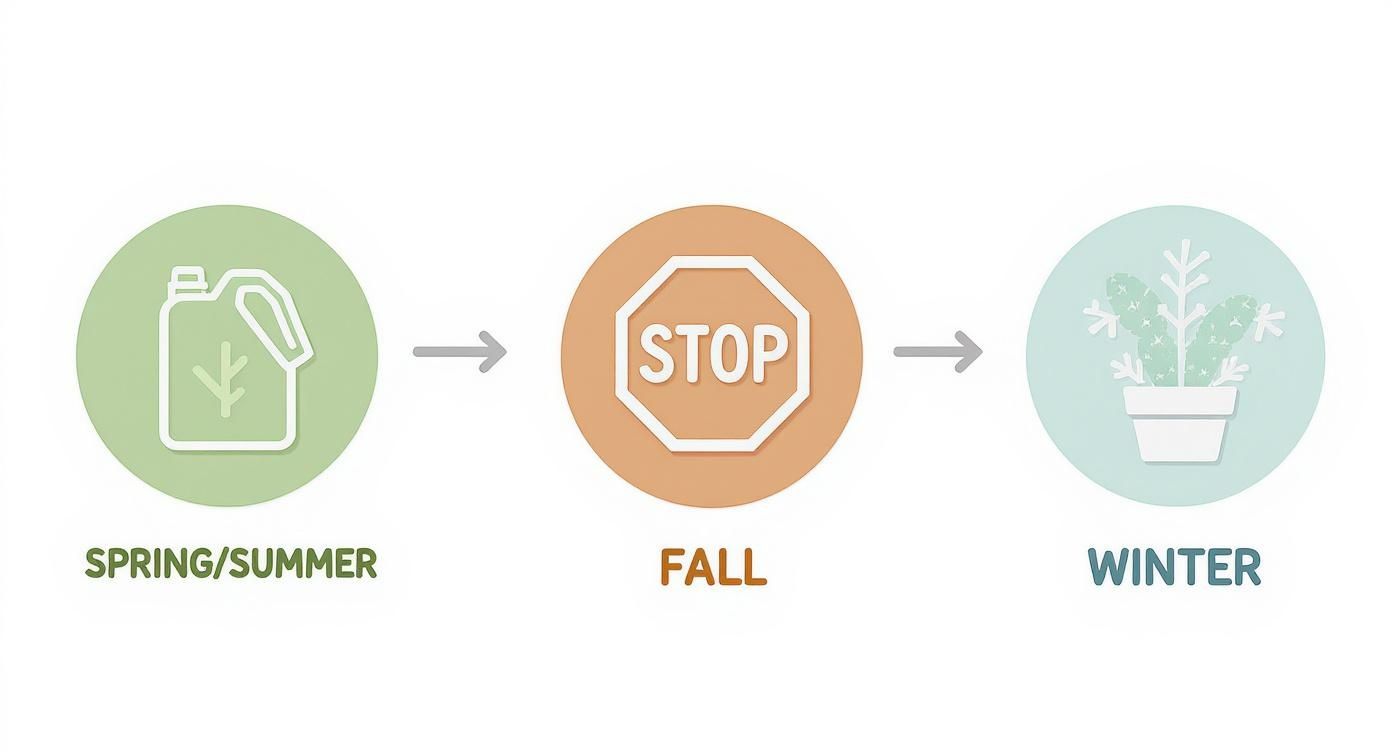
As you can see, cutting out fertilizer in the fall is just as important as managing light exposure to get your cactus ready for its winter show.
During this same six-to-eight-week stretch, you also need to provide cooler nighttime temperatures. Aim for something in the 50-55°F (10-13°C) range. An unheated room, a basement, or even a spot near a slightly drafty window usually does the trick.
Once you spot those tiny flower buds appearing at the very tips of the segments, you've done it! You can end the daily dark treatment and move your cactus back to its regular location. Just follow this simple game plan, and you can count on your plant bursting into bloom right on schedule for the holidays.
Troubleshooting Your Christmas Cactus
Even the most seasoned plant parents run into trouble now and then. If your Christmas cactus looks a little under the weather, don't panic. These plants are pretty communicative, and most common issues are surprisingly easy to fix once you know what to look for.
Why Are the Flower Buds Falling Off?
It’s incredibly frustrating when your plant is covered in beautiful buds one day, only to find them on the floor the next. This phenomenon, called bud drop, is almost always a reaction to a sudden change in its environment.
These cacti are creatures of habit. A quick shift in light, a blast of cold air from a nearby window, or even a sudden change in your watering schedule can stress them out enough to make them drop their precious buds. The key is consistency, especially as they get ready to bloom.
Dealing with Root Rot
Root rot is the number one killer of these plants, and it comes from one thing: too much water. If the base of the stems feels soft and mushy or looks discolored, you probably have a problem lurking beneath the soil. The roots are suffocating and starting to decay, which means the plant can't get the nutrients it needs.
If you suspect root rot, you need to act fast. Here’s how to give your plant a fighting chance:
- Carefully slide the plant out of its pot.
- Examine the roots. Healthy roots are firm and white; rotted ones will be dark, mushy, and might even smell bad.
- Using a clean pair of scissors or shears, trim away every bit of the rotted material.
- Repot the healthy part of the plant in a fresh, dry, well-draining soil mix.
After repotting, wait a few days before you water it. This lets the cut roots callous over and heal, preventing the rot from starting all over again.
When in doubt, let it dry out. A Christmas cactus will forgive you for underwatering far more easily than it will for overwatering.
Pesky Pests and How to Handle Them
Thankfully, Christmas cacti don't attract too many pests, but you might occasionally spot a few unwanted visitors.
Mealybugs are a common culprit. They look like tiny, fuzzy bits of white cotton and love to tuck themselves into the little crevices where the leaf segments connect. You might also encounter spider mites, which are minuscule and hard to see, but they leave behind a tell-tale sign: delicate, silky webbing on the plant.
For a minor pest issue, just dip a cotton swab in rubbing alcohol and dab it directly on the bugs. For a more widespread problem, a thorough spray with an insecticidal soap or a neem oil solution will usually do the trick without harming your plant.
Troubleshooting Your Christmas Cactus
Even the most seasoned plant parent runs into the occasional hiccup. Let's walk through a few of the most common questions I hear about Christmas cactus care, so you can tackle any issues that pop up.
Why Are the Leaves on My Christmas Cactus Limp?
Limp, floppy segments are almost always a sign of a watering problem. The tricky part? It can mean either overwatering or underwatering. The only way to know for sure is to get your fingers in the soil.
Is the soil bone-dry and pulling away from the pot's edge? Your plant is definitely thirsty. Give it a good, thorough drink, and you should see it perk up within a day or so. On the other hand, if the soil is heavy and waterlogged, you've overdone it. This can lead to root rot. Let the soil dry out completely before you even think about watering it again.
The biggest mistake I see people make is watering on a rigid schedule. Always, always check the soil first. It's a simple habit that prevents 90% of common cactus problems.
How Do I Get a Fuller, Bushier Plant?
If you want to encourage a more robust, full-looking cactus, a little pruning can work wonders. The best time to do this is about a month after it has finished blooming, which for most people is late winter or early spring.
It's surprisingly easy. Just use your fingers to gently twist off one or two of the segments from the end of each main stem. This little pinch encourages the plant to branch out right from that spot. Soon, you'll see two new segments growing where there was just one, leading to a much denser plant over time.
Can a Christmas Cactus Go Outside for the Summer?
Absolutely! A little summer vacation outdoors can do your Christmas cactus a world of good. The key is finding the right spot. You need a shady, protected area, like under a covered porch or a leafy tree, where it won't get blasted by direct, scorching sun.
The boost in natural humidity and better airflow often stimulates a ton of new growth. Just make sure to bring it back inside long before the first frost is expected in the fall. This outdoor stint can really invigorate your plant and set it up for a spectacular bloom season.

